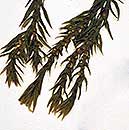Huperzia ophioglossoides (Lam.) Rothm.
Synonyms |
Lycopodium ophioglossoides Lam. |
|---|---|
Common name |
|
Description |
Stems pendulous, repeatedly dichotomously branched, (10-)30-150 x 1-1.5 cm including leaves. Foliage leaves 8-20 × 1-3(-4) mm, 2-3 ranked, loosely overlapping, standing out from the branches, narrowly lanceolate in outline, apex tapering to pointed, firmly herbaceous. Fertile portion of the stem clearly recognizable, 2-40 cm long, dichotomously branched, often interrupted by a group of vegetative leaves. Sporophylls 2-4 x 1-1.5 mm, distinctly smaller than the foliage leaves, broadly ovate in outline, adpressed or closely overlapping but often not entirely hiding the axis, often shiny. Sporangia yellow, 1.2-1.5 mm wide. |
Notes | H. ophioglossoides has a narrow and long fertile portion with sporophylls that are much smaller than the foliage leaves. |
Derivation | ophioglossoides: like Ophioglossum, the fertile portion of the stem resembling the fertile spike of Ophioglossum. |
Habitat | Deep shade in moist evergreen forest, bamboo, mist forest. |
Distribution worldwide | Africa, Comoro Isl., Madagascar, Mauritius, Réunion, Seychelles. |
Distribution in Africa |
Burundi, Cameroon, Congo, Dem. Republic of Congo, Equatorial Guinea (incl. Bioko), Ethiopia, Kenya, Malawi, Mozambique, Rwanda, South Africa, Sudan and South Sudan, Tanzania , Uganda, Zimbabwe. |
Growth form |
Epiphytic, lithophytic. |
Literature |
|

